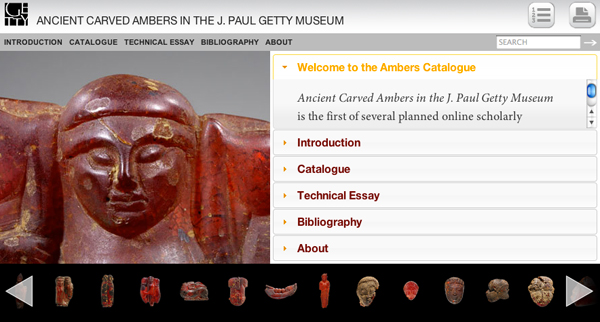 We just launched our first online scholarly catalogue, Ancient Carved Ambers in the J. Paul Getty Museum, available at museumcatalogues.getty.edu/ambers.
We just launched our first online scholarly catalogue, Ancient Carved Ambers in the J. Paul Getty Museum, available at museumcatalogues.getty.edu/ambers.
This catalogue was a collaborative effort between our Publications team, the Museum’s curatorial and conservation staff, and the department I work in, Collection Information & Access, also in the Museum. This is the first digital museum catalogue we’ve done and it presented an interesting new paradigm for the publication process. As the software architect for this project, I want to share my reflections—and issue some cautions.
Writing for Print Is Not the Same as Writing for Digital
The manuscript was authored as a print publication. While the content in this case is a scholarly constant, like anything else it benefited from sensitivity to its intended medium.
We made a small number of additions based on online needs. For instance, we developed an index of subject terms to help visitors find objects by subject (animals, female figures), geographic origin (Egypt, Ionia), context (childbirth, funerals), and so on. We focused on adapting existing content and its structure for the Web, rather than on major rewriting or restructuring.
Digital Publishing Requires More, Not Less, Skill and Expertise
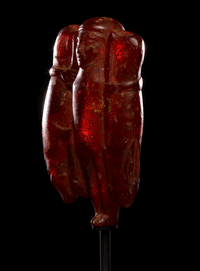
A glimpse of the disabled “lollipop” viewer with Pendant: Divinity Holding Hares, Etruscan, 600–550 B.C. Height: 97 mm; width: 64 mm; depth: 24 mm; Diameter of suspension holes: 2.5 mm; Weight: 76 g. Gift of Gordon McLendon. The J. Paul Getty Museum, 77.AO.82
We had limited technical resources for this project, but we were eager to get a first digital publication out as soon as possible.
Working with content that was already written, our team focused solely on transforming it. We rapidly moved the source MS Word files into DocBook-like XML documents, then automated their ingest and transformation into the internal object model of the application. We had no trouble handling minor content changes and corrections directly in the XML and re-ingesting them, but as we approached the initial release date, significant content problems surfaced. Given the fact that the material was in XML, it was a tremendous burden on editorial and technical staff to track and implement a massive number of changes in a bewildering, unfriendly editing environment.
The shift from print to digital publishing requires new ways of thinking about content and presentation. For example, electronic formats make it possible to include interactive, time-based media and this calls for additional skills and expertise to develop, design, display, sustain, and archive.
There Will Be Limitations and Constraints
Our skilled photography team shot three of the tiny, beautiful, delicate ambers in full 360 degrees, and I developed a fluid viewer dubbed the “lollipop” to feature these photos. The viewer had a complicated technical bug, however, and rather than delay the launch, we decided to move forward without this feature.
Design for a Range of Environments
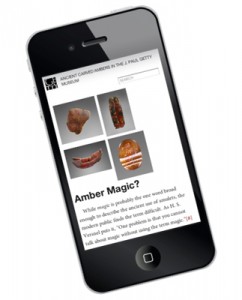
The ambers catalogue has a responsive design, which I think of as an insurance policy against making too many assumptions about the reader’s technical environment. While we didn’t do an extraordinarily sophisticated design, we focused on ensuring a basic level of support for modern browsers running on devices with screen sizes down into the smartphone range. At heart, good design isn’t a technical concern so much as a thoughtful conceptualization of the different scenarios in which people might use the publication. For example, is the reader on a train? Curled up on the couch? By nature, an online scholarly catalogue should be effortlessly portable, enabling the user to examine ancient carved ambers readily in any setting.
…But Don’t Overfocus on the Visuals
Online catalogues are primarily vehicles for scholarship, but they also need an attractive, usable design. These two issues can compete with one another when resources are limited. The more Web conventions you break and the more cutting-edge your presentation is, the more long-term maintenance you’ve burdened yourself with and the more difficult your project will be to transition to new platforms in the future. Also, non-technical scholars will have difficulty using the resource, which defeats the purpose.
Consider Sustainability
Moving forward with scholarly publishing, it remains to be seen how libraries and journals will deal with this work. Do we plan to ensure that digital publications will remain available perpetually? Will we make these works as platform- and technology-neutral as possible? Will we closely integrate with existing methods and tools used by scholars? If we do, that will give us the best chance to be useful today and aligned with future changes.
Arts institutions aren’t the only scholarly community struggling with the digital transition, and we’re certainly not the first. What approach are universities taking? What do journals expect from authors? What can the librarians working on the front line tell us?
Some Thoughts on Ancient Ambers
One of the delights of working on a project like this is the chance to become intimately familiar with a set of objects. It shouldn’t surprise you to learn that I’ve spent a lot of time looking at ancient carved ambers. And yet I haven’t yet tired of examining them. I love boats—I spent several years recently restoring my own, stem to stern—so I would have to choose cat. 7, Pendant: Ship with Figures as my favorite piece.
Our online scholarly catalogue projects have been challenging in all the right ways, raising important questions about the evolving nature of publishing, the organizational structures and processes needed to support new and changing roles, and the need to question status quo and conventional wisdoms in the face of constant, accelerating change.

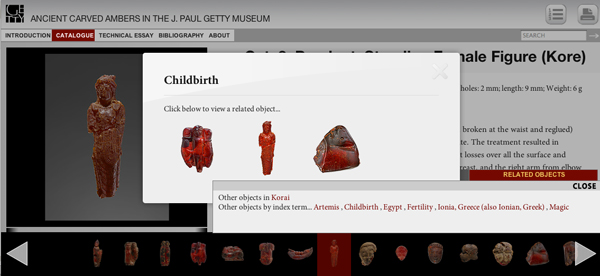
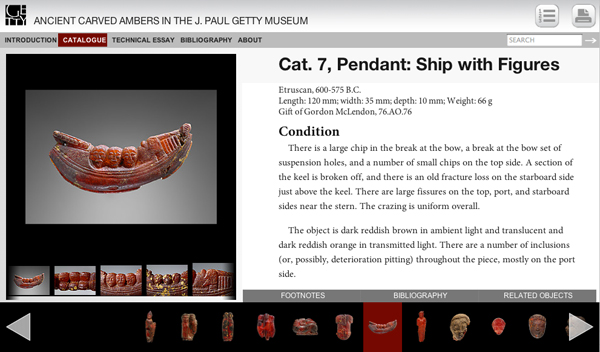



Fascinating. And I love the human voice. And what you say about digital publishing vs. old school is something to ponder as the world is shifting in that direction, EVEN academia.